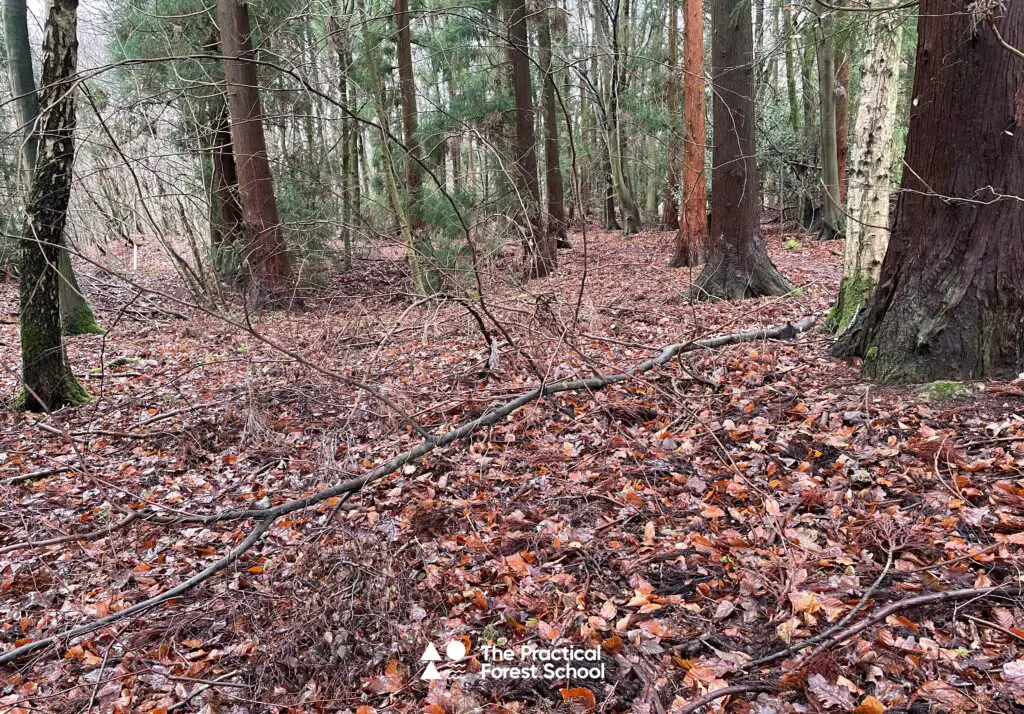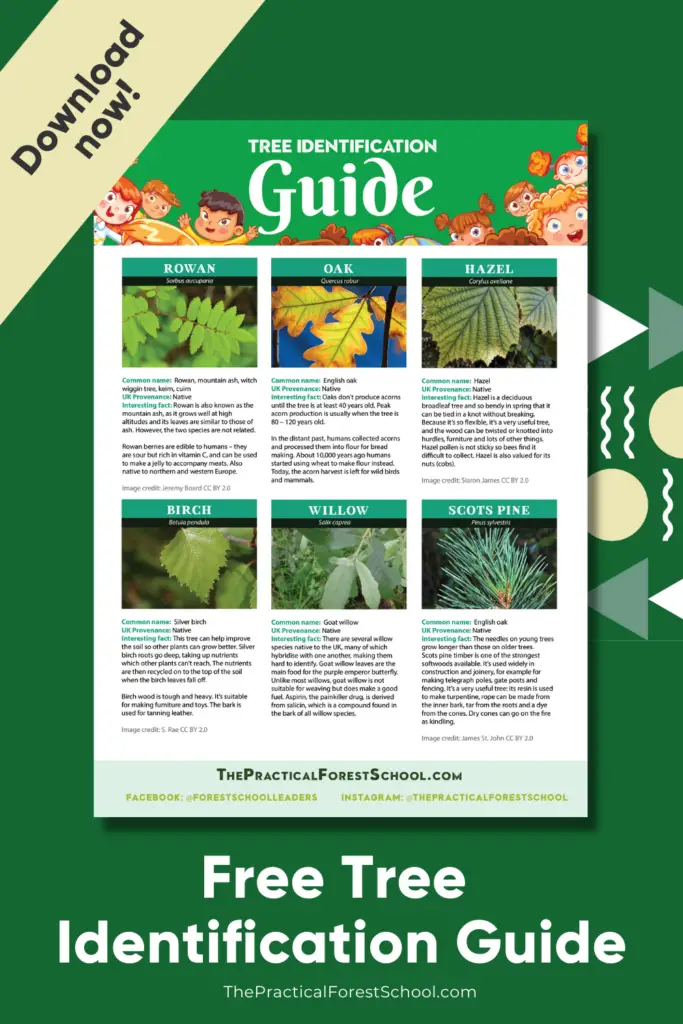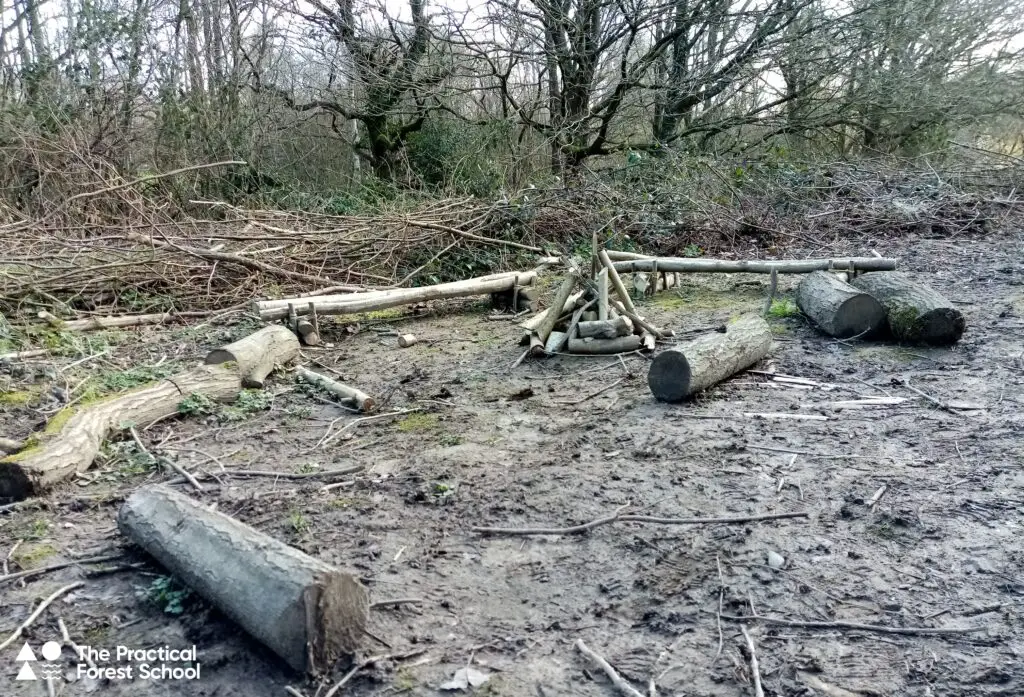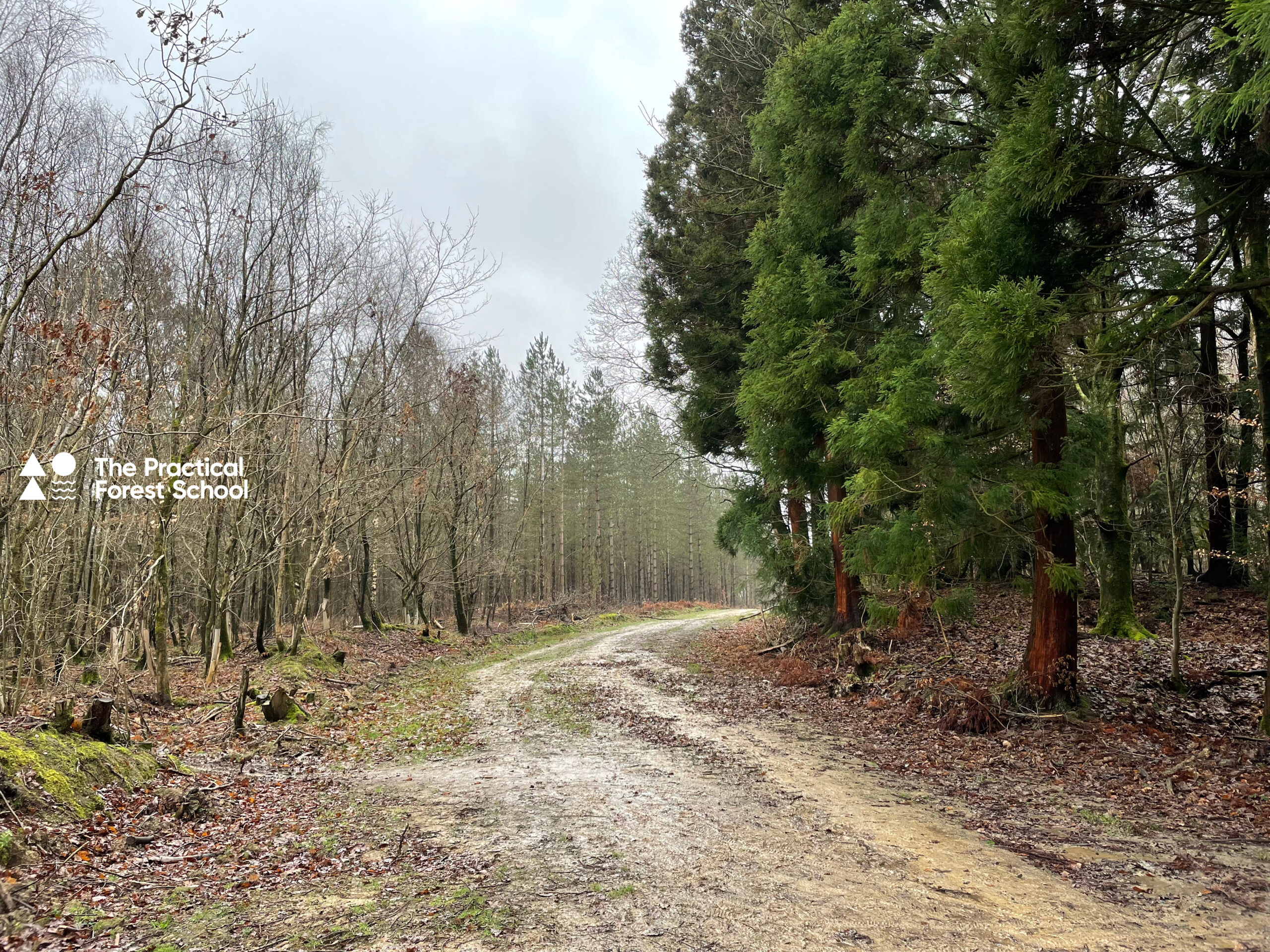Forest School Programmes and the Woodland Environment
This blog is reader-supported. When you purchase something through an affiliate link on this site, we may earn some coffee money. Thanks! Learn more.
Are you taking the Level 3 Forest School Leader training? If so, you’ll need to create a portfolio that showcases your understanding and application of what you have learned. In this article, I’ll share a forest school portfolio example so you can see the kinds of things that are expected.
One of the units in the training is Forest school Programmes and the Woodland Environment – the exact name of your unit might be different, but it will cover the same or similar topics. I completed my Level 3 portfolio in 2018 and below I share an edited version of what I submitted.
This is not offered for you to copy – plagiarism is both not necessary and not supportive of your development as a Forest School Leader. Instead, it’s just to give you some starting points about what kinds of things could be included when you write your own.
The Woodland Environment Unit
This unit has the following learning outcomes:
- Understand the structure of woodlands
- Know how to identify a range of flora and fauna and understand the importance of being able to identify them
- Understand the management of woodlands as a sustainable learning environment
- Understand the importance of the relationship between Forest School and the environment
1. Understand the structure of woodlands
This section assesses your ability to compare the structures and biodiversity of native broadleaf and coniferous woodland ecosystems.

Example from my Level 3 Portfolio:
A woodland can be described as having six vertical layers.
- The canopy is the top layer which includes the tops of the tallest and largest trees.
- The understory is below this and describes the tops of smaller and young trees.
- The shrub layer is where you find bushes such as bramble and young hazel.
- The field layer includes grasses, bracken and wild flowers.
- The ground layer is on the mud where you will spot fungi and moss.
- Finally, the below ground layer is, as it suggests, under the earth and there you’ll find roots.
Include a picture of your forest school setting which you can label to show the distinct layers. Describe what is in the picture – it’s a bonus if you can get a photo that shows several different parts of your environment in the same image, for example the border between a wooded area and a glade.
Level 3 Portfolio example:
The structure of a woodland is determined by the type of trees that grow there, and woodlands with deciduous broadleaf trees are different to those that have coniferous trees. If you consider what those environments look like in early Spring, the broadleaf woodland has much more greenery, bluebells on the field layer and young leaves below the canopy. The coniferous woodland would look darker and browner in colour due to the difference in levels of sunlight reaching the forest floor.
Where leaves fall from the trees, light can reach the ground making it the perfect habitat for bluebells. However, later in the year, when the leaves have grown back fully, shade-loving plants will take their place.
Coniferous trees keep their needles all year round and create constant shade, making it difficult for anything to grow.
Include some pictures of the different areas of trees in your forest school settings with some narrative about what they show, describing leaves, seasons, what’s on the field layer and how the environment will change over time and why.
You also need to describe the biodiversity of the woodland, and it makes sense to do this in a way that sets your forest school area at the centre, assuming you already have identified a group and location in which to do your assessed sessions.
Describe the different habitats in your forest school setting and how these support the biodiversity of the environment. Include photos showing the different habitats e.g. pond dipping area, woodland, glade/field area, fire circle area, stream and so on. Add narrative that describes the animals and insect life found in these areas.
Example of a food chain:
The cat is our top predator. He is attracted to our area because there are lots of areas of long grass to hide in and low branches to pounce from. There are a number of small animals to hunt including frogs, toads and mice. Frogs like the long grass and have easy access to the dipping pond where they can lay their spawn in the spring. Frongs hunt live prey such as worms, snails, slugs and larvae.
There are plenty of earthworms in our area, especially where poor drainage ensures the ground remains damp. They eat plants, droppings and bits of dead animal so they are important for soil improvement. At the bottom of the food chain we have leaves which provide food for lots of different animals, insects and bugs. They are eaten when alive on the tree and also when they have fallen to the ground.
2. Identify a range of flora and fauna
The assessment criteria of this section of the unit are being able to explain why identification is important to the forest school leader and being able to identify flora and fauna on your own site along with characteristics for each species.
Example from my Level 3 Forest School Portfolio:
One of the many things I learned from Richard Louv’s book, Last Child in the Woods, was how important it is for a Forest School Leader to be able to pass on knowledge of identification to children. If we want the next generation to care about the environment, then they have to be given the language and knowledge to label it and talk about it.
Without that knowledge, a tree is just a tree.
If they can name it and know that it helps you light a fire and provides you with a drink in spring, they will remember it’s a birch tree. Learning the name of a tree or plant is just the start of it – they can go on to learn how to use it and understand the importance of it to the setting and how it is essential to look after and respect it.
I went on to describe the value of plant identification for safety reasons and for feeling safe within the environment itself. Draw on your own reading and understanding to explain why it’s worth being able to pass this knowledge on to others and how knowing about flora and fauna helps you lead forest school sessions in a better way.
Example of identifying flora/fauna at your site
To meet this criteria, I created a Tree ID guide (which you can download here) to use as part of a game to help children learn about trees. You could do something similar or describe ways that you have identified what is in your location.

For the fauna, I took pictures of various insects and animals photographed on the site. It’s fine to use the same image twice. For example, I used the same photo of a frog here that I also used as part of the description of the food chain on the site.
Under the pictures, describe the fauna in a few sentences.
3. Understand the management of woodlands as a sustainable learning environment
The assessment criteria for this section are being able to describe woodland management methods and their significance to sustainability and explaining ways to involve participants in sustainable woodland management on a forest school site.

Level 3 Portfolio Example:
The local conservation group has improved the site by the creation of habitats. For example, there was no still water, despite there being many streams, so they created a pond which has become a home for frogs and other animals. They have also built homes for bees and other insects. Dead wood is carefully managed by creating dead hedges with fallen branches or shrubs that have been cut back. The dead hedges not only help manage access to where the public can and can’t go, but they also provide a home for insects. Dead tree trunks are left standing to provide homes for birds such as woodpeckers.
I go on to describe the relationship with the conservation group, more work that has been carried out to support biodiversity in the area and how they tackle invasive species. It would be good to link this section to your forest school area and include a couple of different woodland management methods like coppicing, thinning trees and so on.
Level 3 Portfolio Example:
There are lots of ways to involve participants in the management of the site. There is an ongoing task to cut back bramble and nettles. The children love cutting brambles with the loppers and using a hook on the nettles. And when possible, I like to teach them how to use what they have cut, for example making a basket from bramble or string from nettles as this helps them understand how we can benefit from sustainable management of our site.
I go on to talk about how children have been involved in other woodland management activities and provide examples, as well as commenting on the value of leaving an area unmanaged as a comparison.
4. Understand the importance of the relationship between Forest School and the environment
This section has the following assessment criteria: evaluate research articles on the benefits of connection with woodland environments on well-being and explain how forest school nurtures connection between participants and the woodland environment.
You may already have identified and reviewed research in other areas of your portfolio, so you could reference them here, or you could pick another piece to assess. I discussed Green Mind Theory.
Forest School Level 3 Portfolio Example:
Being outside and connecting with woodland environments is an important part of Forest School. One of the good things about doing an after school club is that it is very much long term, with children coming back year after year and they are able to develop a long-term connection with the woodland.
I also discussed a conversation I had at Under One Tree, the FSA National Conference about the activities that help a child’s brain to relax and calm down, as well as the relationships I have seen between children and the environment in my own groups. Draw on your own experiences here and use a few examples.
Creating your portfolio
Your training provider will probably provide guidance notes – I got helpful guidance notes from the Sussex Wildlife Trust which were useful in identifying the keywords and topics to include in my responses. The notes also sometimes provided a word length, which was helpful. In general, concise is good! Assessors have a lot of portfolios to read so address the topic but don’t waffle!
Your trainer will also have advice, and my group created a WhatsApp group so there was a lot of chat on there as we went through our training.
Good luck with your Forest School Leader training!
Read next:
- Practical Skills for a Forest School Programme
- Learning and Development at a Forest School Programme
- Planning and Preparation at a Forest School Programme
- Delivery of a Forest School Programme

About the author: Jon Borley
Jon qualified as a Level 3 Forest School Leader with the Sussex Wildlife Trust. He works independently as a practitioner running forest school clubs and also within schools both in a forest school capacity and as an outdoor learning teaching assistant, working with preschoolers to secondary-aged children. He has previously led sessions for adults as part of professional development events for the Sussex FSA, and is a member of MIAS.
